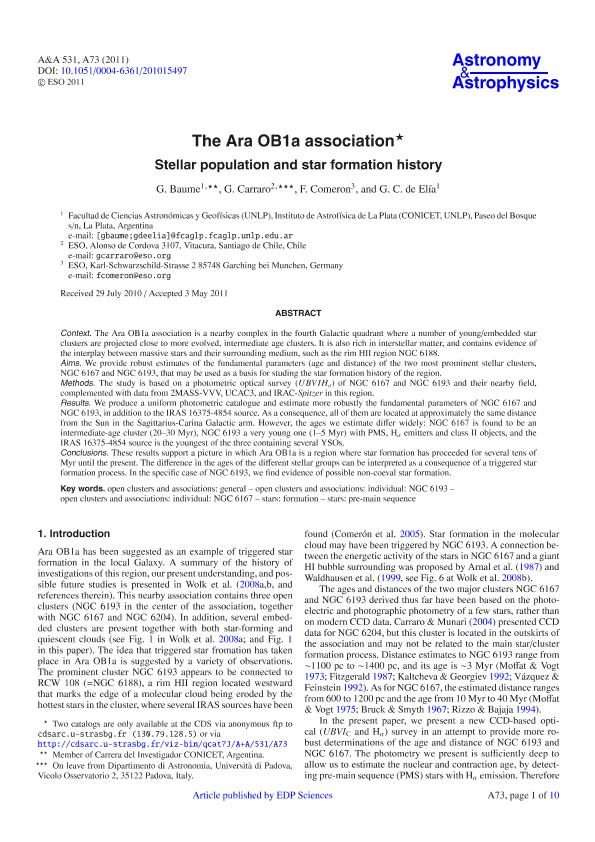Mostrar el registro sencillo del ítem
dc.contributor.author
Baume, Gustavo Luis

dc.contributor.author
Carraro, Giovanni

dc.contributor.author
Comeron, F.
dc.contributor.author
de Elia, Gonzalo Carlos

dc.date.available
2018-08-07T14:58:56Z
dc.date.issued
2011-07
dc.identifier.citation
Baume, Gustavo Luis; Carraro, Giovanni; Comeron, F.; de Elia, Gonzalo Carlos; The Ara OB1a association: Stellar population and star formation history; EDP Sciences; Astronomy and Astrophysics; 531; 7-2011; 73-82
dc.identifier.issn
0004-6361
dc.identifier.uri
http://hdl.handle.net/11336/54413
dc.description.abstract
Context. The Ara OB1a association is a nearby complex in the fourth Galactic quadrant where a number of young/embedded star clusters are projected close to more evolved, intermediate age clusters. It is also rich in interstellar matter, and contains evidence of the interplay between massive stars and their surrounding medium, such as the rim HII region NGC 6188. Aims. We provide robust estimates of the fundamental parameters (age and distance) of the two most prominent stellar clusters, NGC 6167 and NGC 6193, that may be used as a basis for studing the star formation history of the region. Methods. The study is based on a photometric optical survey (UBVIHα) of NGC 6167 and NGC 6193 and their nearby field, complemented with data from 2MASS-VVV, UCAC3, and IRAC-Spitzer in this region. Results. We produce a uniform photometric catalogue and estimate more robustly the fundamental parameters of NGC 6167 and NGC 6193, in addition to the IRAS 16375-4854 source. As a consequence, all of them are located at approximately the same distance from the Sun in the Sagittarius-Carina Galactic arm. However, the ages we estimate differ widely: NGC 6167 is found to be an intermediate-age cluster (20-30 Myr), NGC 6193 a very young one (1-5 Myr) with PMS, Hα emitters and class II objects, and the IRAS 16375-4854 source is the youngest of the three containing several YSOs. Conclusions. These results support a picture in which Ara OB1a is a region where star formation has proceeded for several tens of Myr until the present. The difference in the ages of the different stellar groups can be interpreted as a consequence of a triggered star formation process. In the specific case of NGC 6193, we find evidence of possible non-coeval star formation. © 2011 ESO.
dc.format
application/pdf
dc.language.iso
eng
dc.publisher
EDP Sciences

dc.rights
info:eu-repo/semantics/openAccess
dc.rights.uri
https://creativecommons.org/licenses/by-nc-sa/2.5/ar/
dc.subject
Open Clusters And Associations: General
dc.subject
Open Clusters And Associations: Individual: Ngc 6167
dc.subject
Open Clusters And Associations: Individual: Ngc 6193
dc.subject
Stars: Formation
dc.subject
Stars: Pre-Main Sequence
dc.subject.classification
Astronomía

dc.subject.classification
Ciencias Físicas

dc.subject.classification
CIENCIAS NATURALES Y EXACTAS

dc.title
The Ara OB1a association: Stellar population and star formation history
dc.type
info:eu-repo/semantics/article
dc.type
info:ar-repo/semantics/artículo
dc.type
info:eu-repo/semantics/publishedVersion
dc.date.updated
2018-07-11T14:19:30Z
dc.journal.volume
531
dc.journal.pagination
73-82
dc.journal.pais
Francia

dc.journal.ciudad
Paris
dc.description.fil
Fil: Baume, Gustavo Luis. Consejo Nacional de Investigaciones Científicas y Técnicas. Centro Científico Tecnológico Conicet - La Plata. Instituto de Física La Plata. Universidad Nacional de La Plata. Facultad de Ciencias Exactas. Instituto de Física La Plata; Argentina. Universidad Nacional de La Plata. Facultad de Ciencias Astronómicas y Geofísicas; Argentina
dc.description.fil
Fil: Carraro, Giovanni. ESO; Chile
dc.description.fil
Fil: Comeron, F.. ESO; Alemania
dc.description.fil
Fil: de Elia, Gonzalo Carlos. Consejo Nacional de Investigaciones Científicas y Técnicas. Centro Científico Tecnológico Conicet - La Plata. Instituto de Física La Plata. Universidad Nacional de La Plata. Facultad de Ciencias Exactas. Instituto de Física La Plata; Argentina. Universidad Nacional de La Plata. Facultad de Ciencias Astronómicas y Geofísicas; Argentina
dc.journal.title
Astronomy and Astrophysics

dc.relation.alternativeid
info:eu-repo/semantics/altIdentifier/doi/https://dx.doi.org/10.1051/0004-6361/201015497
dc.relation.alternativeid
info:eu-repo/semantics/altIdentifier/url/https://www.aanda.org/articles/aa/abs/2011/07/aa15497-10/aa15497-10.html
Archivos asociados
